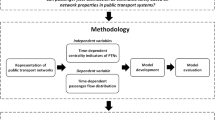Abstract
The day-to-day reliability of transportation facilities significantly affects travel behavior. To better understand how travelers use these facilities, it is critical to understand and characterize this reliability for different facilities. Early work in this area assumed that the variance of day-to-day travel times (a measure of the inverse of reliability) increases proportionally with the mean travel time; i.e., as the mean travel time increases, travel time reliability decreases. However, recent empirical data for a single bottleneck facility and a small urban network suggest a more complex relationship that exhibits hysteresis. When this phenomenon is present, the variance in travel time is larger as the mean travel time decreases (congestion recovery) than as the mean travel time increases (congestion onset). This paper presents an elegant theoretical model to describe the variance of travel times across many days in an urban network. This formulation shows that the hysteresis behavior observed in empirical floating car data on urban networks should not be unexpected, and that it is linked to the hysteresis loops that often exist in the Macroscopic Fundamental Diagram of urban traffic. To verify the validity of this formulation, data from a micro-simulation of the City of Orlando, Florida, are used to derive an observed relationship with which to compare to theory. The simulated data are shown to match the theoretical predictions very well, and confirm the existence of hysteresis in the relationship between the mean and variance of travel times that is suggested by theory. These results can be used as a first step to more accurately represent travel time reliability in future models of traveler decision-making.








Similar content being viewed by others
Notes
Note that we consider here only the instantaneous travel time as defined in this manner. Actual travel times of individual vehicles whose trips span multiple analysis periods (i.e., individual vehicles “experienced” travel times) can be determined by taking a weighted average of the instantaneous travel times using the amount of time spent in each period as a weight.
References
Aboudolas K, Papageorgiou M, Kouvelas A, Kosmatopoulos EB (2010) A rolling-horizon quadratic-programming approach to the signal control problem in large-scale congested urban road networks. Transp Res Part C 18(5):680–694
Ardekani S, Herman R (1987) Urban network-wide traffic variables and their relations. Transp Sci 21(1): 1–16
Asensio J, Matas A (2008) Commuters valuation of travel time variability. Transp Res Part E 44(6): 1074–1085
Bates J, Dix M, May T (1987) Travel time variability and its effect on time of day choice for the journey to work. Transportation planning methods In: Proceedings of seminar C held at the PTRC summer annual meeting, pp 293–311
Bates J, Polak J, Jones P, Cook A (2001) The valuation of reliability for personal travel. Transp Res Part E 37(2): 191–229
Bates J, Fearon J, Black I (2003) Frameworks for modeling the variability of journey times on the highway network: a report for UK Department for Transport. Department for Transport, UK
Brownstone D, Small KA (2005) Valuing time and reliability: assessing the evidence from road pricing demonstrations. Transp Res Part A 39(4): 279–293
Buisson C, Ladier C (2009) Exploring the impact of homogeneity of traffic measurements on the existence of macroscopic fundamental diagrams. Transp Res Rec 2124:127–136
Daganzo CF (2007) Urban gridlock: macroscopic modeling and mitigation approaches. Transp Res Part B 41(1): 49–62
Daganzo CF, Gayah VV, Gonzales EJ (2012) The potential of parsimonious models for understanding large scale transportation systems and answering big picture questions. Eur J Transp Logist
Daganzo CF, Geroliminis N (2008) An analytical approximation for the macroscopic fundamental diagram of urban traffic. Transp Res Part B 42(1): 771–781
Daganzo CF, Gayah VV, Gonzales EJ (2011) Macroscopic relations of urban traffic variables: bifurcations, multivaluedness and instability. Transp Res Part B 45(1): 278–288
Dixit VV, Crowe J, Radwan E (2009) Evaluation and microscopic simulation of the Orlando downtown network. In: Final report submitted to the City of Orlando, Department of Transportation
Dixit VV, Crowe J, Radwan E (2011) The calibration and validation of microsimulation using the two-fluid model. In: Proceedings of the 90th annual meeting of the Transportation Research Board
Edie LC (1965) Discussion of traffic stream measurements and definitions. In: Proceedings of the 2nd international symposium on the theory of traffic flow, pp 139–154
Fosgerau M (2010) On the relation between the mean and variance of delay in dynamic queues with random capacity and demand. J Econ Dyn Control 34(4): 598–603
Gayah VV, Daganzo CF (2011) Clockwise hysteresis loops in the macroscopic fundamental diagram: an effect of network instability. Transp Res Part B 45(4): 643–655
Gayah VV, Daganzo CF (2012) Analytical capacity comparison of one-way and two-way signalized street networks. Transp Res Rec 2301:76–85
Gayah VV, Dixit VV (2013) Using mobile probe data and the macroscopic fundamental diagram to estimate network densities. Transp Res Rec (in press)
Geroliminis N, Daganzo CF (2007) Macroscopic modeling of traffic in cities. In: Proceedings of the 86th annual meeting of the Transportation Research Board
Geroliminis N, Daganzo CF (2008) Existence of urban-scale macroscopic fundamental diagrams: some experimental findings. Transp Res Part B 42(9): 759–770
Geroliminis N, Sun J (2011) Hysteresis phenomena of a macroscopic fundamental diagram in freeway networks. Transp Res Part A 45(9): 966–979
Godfrey J (1969) The mechanism of a road network. Traffic Eng Control 11(7): 323–327
Haddad J, Geroliminis N (2012) On the stability of traffic perimeter control in two-region urban cities. Transp Res Part B 46(1): 1159–1176
Herman R, Prigogine I (1979) A two-fluid approach to town traffic. Science 204(4389) 148–151
Hollander Y (2006) Direct versus indirect models for the effects of unreliability. Transp Res Part A 40(9): 699–711
Keyvan-Ekbatani M, Kouvelas A, Papamichail I, Papageorgiou M (2012) Exploiting the fundamental diagram of urban networks for feedback-based gating. Transp Res Part B 46(10): 1393–1403
Knoop VL, Hoogdendoorn S, Van Lint JWC (2012) Routing strategies based on the macroscopic fundamental diagram. Transp Res Rec 2315:1-10
Koster P, Verhoef E (2012) A rank dependent scheduling model. J Transp Econ Policy 46(1): 123–138
Li Z, Hensher DA, Rose JM (2010) Willingness to pay for travel time reliability in passenger transport: a review and some new empirical evidence. Transp Res Part E 46(3): 384–403
Peer S, Koopmans C, Verhoef E (2010) Predicting travel time variability for cost-benefit analysis. http://www.tinbergen.nl/discussionpapers/10071.pdf. Accessed 8 July 2011
Polak P (1987) A more general model of individual departure time choice transportation planning methods. In: Proceedings of seminar C held at the PTRC summer annual meeting, pp 247–258
Polak J, Hess S, Liu X (2008) Characterizing heterogeneity in attitudes to risk in expected utility models of mode and departure time choice. In: Proceedings of the Transportation Research Board 87th annual meeting
Saberi M, Mahmassani HS (2012) Exploring properties of networkwide flow–density relations in a freeway network. Transp Res Rec 2315:153–163
Sirivadidurage S, Gordon A, White C, Watling D (2009) Forecasting day to day variability in travel times on the UK motorway network. In: Proceedings of the European transportation conference
Small KA (1999) Valuation of travel-time savings and predictability in congested conditions for highway user-cost estimation. Transportation Research Board, National Research Council
Strategic Highway Research Program (2010) Analytical procedures for determining the impacts of reliability mitigation strategies. In: Final report, SHRP2 project L03
Van Lint JWC, van Zuylen HJ, Tu H (2008) Travel time unreliability on freeways: why measures based on variance tell only half the story. Transp Res Part A 42(1): 258–277
Vickrey W (1969) Congestion theory and transport investment. Am Econ Rev 59(2): 251–260
Acknowledgments
We would like to thank three anonymous reviewers for their comments and suggestions that helped to improve this paper
Author information
Authors and Affiliations
Corresponding author
Rights and permissions
About this article
Cite this article
Gayah, V.V., Dixit, V.V. & Guler, S.I. Relationship between mean and day-to-day variation in travel time in urban networks. EURO J Transp Logist 3, 227–243 (2014). https://doi.org/10.1007/s13676-013-0032-2
Received:
Accepted:
Published:
Issue Date:
DOI: https://doi.org/10.1007/s13676-013-0032-2




